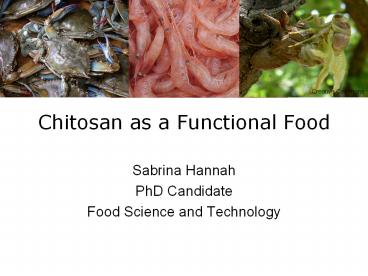Chitosan as a Functional Food - PowerPoint PPT Presentation
1 / 20
Title:
Chitosan as a Functional Food
Description:
Creative Commons Chitosan as a Functional Food Sabrina Hannah PhD Candidate Food Science and Technology What is Chitosan? Polysaccharide - copolymer of: glucosamine N ... – PowerPoint PPT presentation
Number of Views:1104
Avg rating:5.0/5.0
Title: Chitosan as a Functional Food
1
Chitosan as a Functional Food
Creative Commons
- Sabrina Hannah
- PhD Candidate
- Food Science and Technology
2
What is Chitosan?
- Polysaccharide - copolymer of
- glucosamine
- N-acetyl glucosamine
- Chitosan oligosaccharides also important
- Derived from chitin
- 2nd most abundant naturally occuring
polysaccharide - Anthropod shells, fungi, brown algae
Creative Commons
3
Chitin
Chitosan
4
Potential Health Effects
5
Chitosan and Dietary Fats
- Fats Bound Include
- Fatty Acids
- Bile acids
- Triglycerides
- Cholesterol
- Other sterols
Shahidi, et al, 2004 Hennen, 1996
6
Weight Loss Cholesterol Lowering Effects
- Demonstrated effective in animal and human trials
- Most effective in combination with diet
adjustment - Effectiveness is enhanced by ascorbic acid
- Properties and means of administration are
important
7
Fat Digestion in Rats fed Chitosan
Fig. 2. Apparent digestibility of fats and
proteins by rats fed with cellulose or chitosan.
The apparent fat digestibility was calculated as
100 (ingested lipids - fecal lipids) / ingested
lipids. Abbreviations CE, cellulose CEA,
cellulose with ascorbic acid CEN, cellulose with
sodium ascorbate CH, chitosan CHA, chitosan
with ascorbic acid CHN, chitosan with sodium
ascorbate.
chitosan sodium ascorbate
chitosan
chitosan ascorbic acid
Deuchi et al, 1994
8
Cholesterol Lowering in Obese Adult Humans
modified from Veneroni et al, 1996
9
Is it really effective?
- Recent review by Ni Mhurchu et al (2005)
- Randomized controlled studies involving at least
4 week supplementation - 14 studies, 1071 participants
- Dose varied from 1 g/day to 15 g/day
- Found weighted mean difference in weight of -1.7
kg and cholesterol of -0.2mmol/L - Statistically significant differences, but
perhaps not clinically significant
10
Chitosan as a Prebiotic
- Chitosan oligosaccharides improved growth and
growth rate of many Lactobacillus sp. and B.
Bifidum sp.
Lee et al, 2002
11
Antitumor Properties Chitosan Oligosaccharides
- Suzuki et al, 1996, 1992, 1986, 1985
- Immuno-enhancing effect observed in mouse model
- Tokoro et al, 1988
- growth-inhibitory effects observed in a mouse
model - Tsukada et al, 1990
- antimetastic effects in mice with lung cancer
- Kim and Kim, 2006
- Inhibits activation and expression of MMP-2 in
human dermal fibroblasts
12
Calcium Adsorption Helps or Hurts?
- Jeon and Kim, 1997
- Decreased fecal calcium excretion with intake of
chitosan oligosaccharides - Breaking force of rat femurs enhanced by chitosan
consumption - Wada et al, 1997
- Chitosan accelerated urinary excretion of
radiolabeled calcium - Rats fed chitosan exhibited higher retention then
rats fed cellulose - Deuichi et al (1995)
- Mineral adsorption and bone mineral content
decreased by consumption of chitosan in rats
13
Safety and Health Concerns
- LD50 in mice found to be 16 g/day/kg (Kinumaki,
1968) - Gastric dehydration and impaction
- Equates to gt90 g/day in humans (Hennon, 1996)
- Potential Negative Health Effects
- Growth retardation
- Reduced absorption of fat soluble vitamins and
nutrients - Metabolism of beneficial fats prevented
- Alteration of gut microflora
- Potential allergy issues
14
Regulatory Issues
- United States
- 1983 approved by USDA as a feed additive
- 2001 GRAS status request filed but recalled
- Primex (http//www.primex.is/)
- Widely avaliable as a supplement
- Japan, Europe, England, Italy
- Used as a food preservative
- Used as a food additive
- Used as a diet aid
- Chitosan containing products including dietary
cookies, potato chips, noodles are widely
available
15
Other Applications
16
As an Antimicrobial
- Demonstrated effective against Candida, E. Coli,
and Staph. Aureus, Bacillus cereus, Proteus
vulgaris - Evaluated for foods including fruit juices,
emulsified sauces, meat, mayo, tofu, hummus,
salads, shrimp - Demonstrated effective against fungal diseases on
strawberries, kumquats, apples, carrots, pea
pods, pizza and meats - Effective against fungal pathogens
Shahidi, et al, 2004 Jeon et al, 2000
17
As an Edible Film
- Preservative film for fruits and vegetables
- Antimicrobial and Antifungal
- Ripening delay
- Slow respiration rate
- Evaluated on peaches, pears, kiwifruit,
cucumbers, bell peppers, strawberries, tomatoes - Browning prevention
- Demonstrated on Lichi (Zhange and Quantick)
- Anthocyanins, flavonoids, and phenolics were
effected - Potential to replace collagen for meat casing
applications
Shahidi, et al, 2004 Jeon et al, 2000 Bough, 1977
18
As an Antioxidant
- Darmadji and Izumimoto, 1994
- Decrease in beef TBA values with addition of
chitosan - St. Angelo and Vercellotti, 1989
- Decrease in beef TBA values and hexanal levels
- Control of warmed-over flavor with addition of
N-carboxymethylchitosan - Li et al, 1996
- Oxidative rancidity of pork prevented by
N-carboxymethylchitosan - Kamil et al, 2002
- Oxidation prevention in cooked herring observed
through peroxide values, TBARS and volatile
aldehydes
19
As an Additive or Processing Aid
- Juice Clarification
- Control of acidity in juices
- Color adjustment/stabilization
- Texture control
- Thickener
- Stabilizer
- Gel former
- Emulisifying agent
Shahidi, et al, 2004 Jeon et al, 2000 Bough, 1977
20
Questions?































